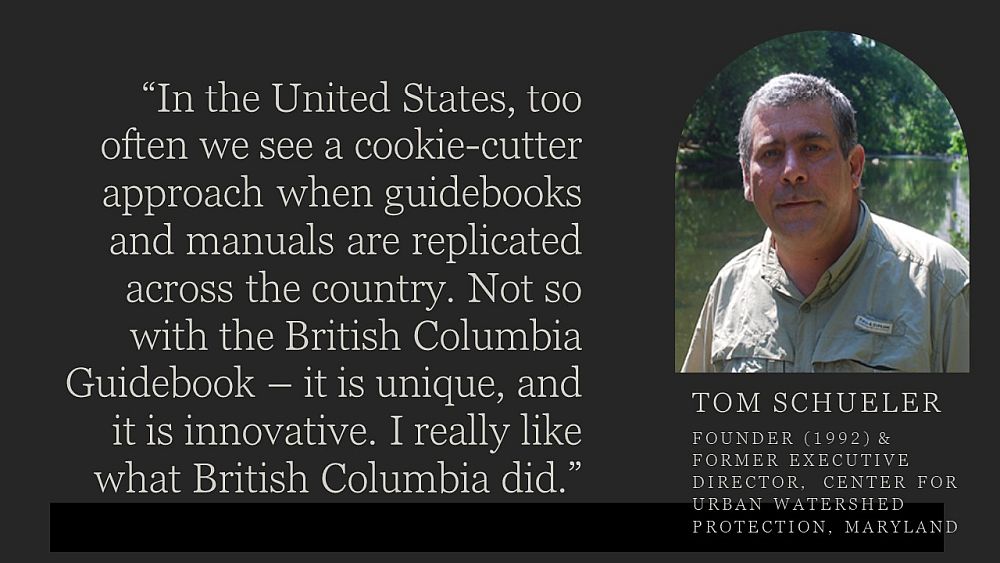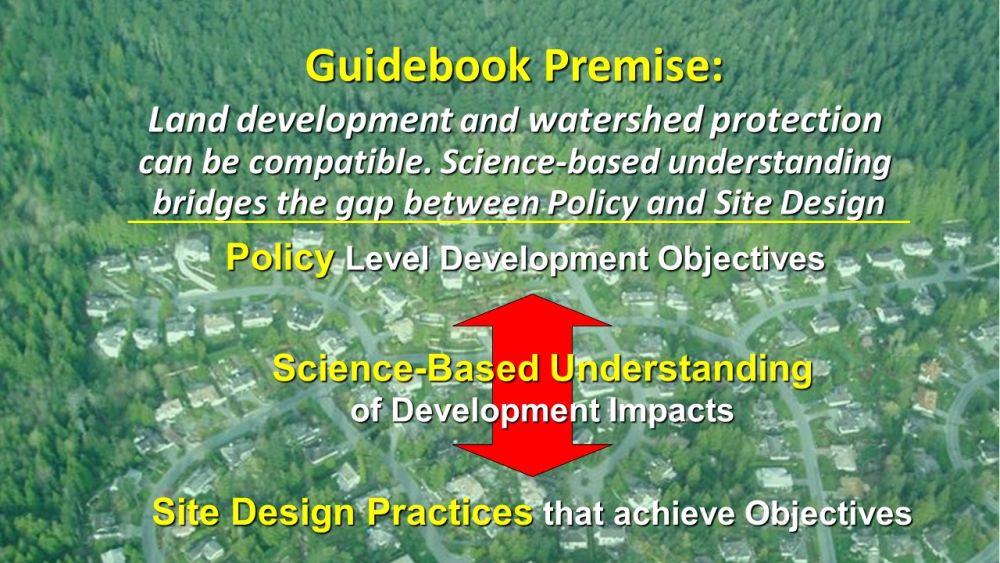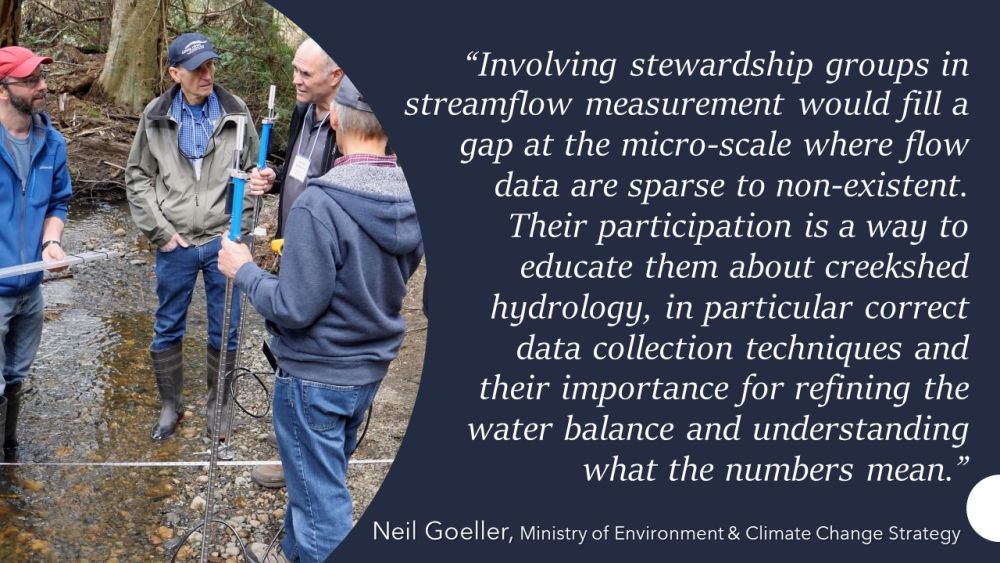STORY BEHIND THE STORY OF ‘STORMWATER PLANNING, A GUIDEBOOK FOR BRITISH COLUMBIA’ (2002): “Key was the collaboration happening within the Ministry of Environment. I had working relationships with other groups. We were talking on an ongoing basis about innovation and how we could provide better levels of protection. The Guidebook is an example of that collaboration,” stated Peter Law, Chair of the former Guidebook Steering Committee, on the 20th anniversary of Guidebook publication (June 2022)
Note to Reader
The edition of Waterbucket eNews published on June 7, 2022 featured Peter Law and the “story behind the story” of Stormwater Planning: A Guidebook for British Columbia, released in June 2002. Without Peter Law, there would have been no Guidebook. Peter saw the need, garnered support within government, and was hands-on in shepherding the Guidebook from inception to completion.
TO LEARN MORE
Download a PDF copy of “Living Water Smart in British Columbia: Land Development and Watershed Protection Can Be Compatible”, or continue reading.

Restore the ‘natural Water Balance’ to stabilize streams, restore aquatic habitat, and sustain summer streamflow
Twenty years ago this June, the government of British Columbia released Stormwater Planning: A Guidebook for British Columbia. This moment of celebration is the opportunity to reflect on what we know in order to foreshadow what comes next.
In 2002, the Guidebook was recognized across North America for its science-based foundation and its innovation. Tom Schueler, the respected thought leader who founded the Center for Urban Watershed Protection, extolled the Guidebook because of the night-and-day contrast with cookie-cutter guides and manuals in the United States.
The Guidebook demonstrates how to apply a Watershed / Landscape-based Approach to Community Planning a description coined by the late, great Erik Karlsen (1945-2020). Developed by a Metro Vancouver intergovernmental working group concurrently with the Guidebook, the importance of this landmark document is now lost in the mists of time.
The Guidebook premise is that land development and watershed protection can be compatible, BUT ONLY IF communities apply systems thinking and Design With Nature to restore the natural water balance.

Guidebook is a Shared Responsibility
The story behind the story is about the visionary leadership of the Ministry of Environment’s Peter Law, Chair of the Guidebook intergovernmental steering committee. Without Peter Law, there would have been no Guidebook. Peter saw the need, garnered support within government, and was hands-on in shepherding the Guidebook from inception to completion.
When the Partnership for Water Sustainability morphed from an intergovernmental technical committee into a non-profit legal entity in 2010, the Ministry of Environment entrusted the Partnership with responsibility as stewards of the Guidebook. Peter Law is a founding Director of the Partnership.

Beyond the Guidebook Series
The Guidebook is the foundation document for the Beyond the Guidebook Series of guidance documents. The titles themselves tell a story about the partnership journey in building on the Guidebook through case studies that showcase and celebrate good work, and advance implementation of science-informed approaches.
Context for Rainwater Management and Green Infrastructure in British Columbia (2007)
Implementing a New Culture for Urban Watershed Protection and Restoration in British Columbia (2010).
Moving Towards “Sustainable Watershed Systems, through Asset Management (2015).
The fourth in the series, scheduled for release in June 2022, is titled A BC Strategy for Community Investment in Stream Systems.

EDITOR’S PERSPECTIVE
“Rollout of the Fish Protection Act in 1997 was the catalyst for my collaboration with Peter Law over the past 25 years. At the time, Peter was a member of the inter-ministry working group tasked with developing the streamside protection regulation. A defining moment was a consultation workshop hosted by the Union of BC Municipalities in October 1997,” stated Kim Stephens, Waterbucket eNews Editor and Partnership Executive Director.
“Washington State’s Bill Derry and I presented what were soon known as the ‘fish pictures’. One of the first stormater utility managers, Bill Derry chaired a local government committee that was instrumental in founding a research centre at the University of Washington. Their mission was to understand and correlate changes on the landscape with impacts on stream system condition.”
“Bill’s committee framed eight key questions. These then defined areas of research by graduate students under the guidance of Dr. Richard Horner. Chris May then pulled together this original research in his PhD dissertation. His doctoral work is the foundation that the Partnership continues to build on as our understanding of the science grows.”

TO LEARN MORE, click on: Mimic the Natural Water Balance
Application of science-based understanding
“The context for B.C.’s Fish Protection Act was the ‘salmon crisis’ in the Salish Sea bioregion. Bill Derry and I developed the ‘fish pictures’ to explain the science of land use change to local government audiences. These graphics were powerful communication tools,” continued Kim Stephens.
“At the conclusion of Bill and my presentation, the chair (Erik Karlsen) of the streamside regulation working group observed, At last, we have a science-based understanding of cause-and-effect. This is our point of departure for action to protect stream systems.“
“Within five years, and as a direct result of Peter Law’s tireless efforts, the provincial government released Stormwater Planning: A Guidebook for British Columbia. The fish pictures are incorporated in the Guidebook.”

CONTEXT: British Columbia was followed by California in 2008 and Washington State in 2012.
A Stream is a system
“Peter Law had a clear and pragmatic vision for developing a Stormwater Guidebook for British Columbia. Guided by a mantra of ‘affordable and effective’, the Guidebook team built on Puget Sound research and validated our ‘made in BC. approach through case study experience,” recalled Kim Stephens.
“A stream is a system, but that is not how land and drainage practitioners treat streams. Moreover, high-level policy statements are often not helpful. To achieve the twin goals of stream stability and aquatic habitat protection, we literally had to re-invent urban hydrology. These one-two drivers resulted in the Water Balance Methodology which transcends the ‘voodoo hydrology’ and simple equations that characterize standard engineering practice.
“Two local governments – City of Chilliwack and the Regional District of Nanaimo – stepped up to serve as Guidebook feedback loops to test the water-centric approach to development planning. Numerous other local governments also contributed (District of North Vancouver, Surrey, Kelowna, Coquitlam, Maple Ridge, Metro Vancouver), as well as the City of Burnaby and the UniverCity Sustainable Community at Simon Fraser University.”

TO LEARN MORE, click on: Re-Inventing Urban Hydrology

Conversational interview with Peter Law about the ‘story behind the story’ of the Stormwater Guidebook
Twenty years after release of the Guidebook, how water gets to a stream and how long it takes, is still not widely understood among drainage practitioners and local government decision-makers. “When I look back, the thing that disappoints me is how long it has taken for the practitioners to apply the approach versus playing lip service to what we were requesting at the time,” stated Peter Law in a moment of reflection.
Leading by example: For the past decade, and as a volunteer streamkeeper, Peter Law has been putting Guidebook principles into practice in Shelly Creek. This is the last fish-bearing stream in the City of Parksville. Peter is Vice-President of the Mid Vancouver Island Habitat Enhancement Society.
With support from the Partnership for Water Sustainability, MVIHES has undertaken a range of demonstration applications that push the envelope of contemporary practices. As Peter Law often reminds those who are curious, “Shelly Creek is an ongoing test case for the Water Balance Methodology”.
A storyline in three parts:
The conversational interview is organized in three parts. In Part One of the storyline, Peter describes how his journey began in 1997. In Part Two, he explains the Guidebook breakthrough which is the science-based Water Balance Methodology. In Part Three, he describes his Shelly Creek mission to make a difference.

PART ONE: How the Guidebook journey began
When the inter-ministry working group was developing the streamside protection regulation in 1997, the presentation on the science of land use change by Kim Stephens and Bill Derry helped us realize that we needed more than a setback to protect aquatic habitat.
The science showed that communities also needed to tackle what was happening on the land that drains to streams. This realization set in motion two parallel paths, the Streamside Protection Regulation which eventually became the Riparian Area Regulation (RAR) and Stormwater Planning: A Guidebook for British Columbia. The focus of streamside setbacks is to protect fish and fish habitat.
For the Guidebook path, I found the opportunity to “look beyond the stream” and address poor water quality from drainage runoff in the Waste Management Act. The opportunity resided in the non-point source provision for Liquid Waste Management Plans (LWMP). The term non-point source pollution, or NPS, was used by my colleagues in the Waste Management Branch to highlight poor quality of runoff from developed and/or developing lands – that is, “stormwater”.
But the NPS provision was not being applied to the issue of how land is developed. So, I asked my colleagues, why not use this mechanism to connect the dots between changes to the land and impacts on streams?

Relationships and collaboration between branches – that is how we moved the Guidebook idea forward within the Ministry of Environment. After the success of the first of the SmartStorm Forums in January 1999, I made a pitch to the Regional Director and Section Head for Waste Management. They saw the utility in the idea. The next step was getting buy-in from a senior manager in Victoria. She thought the idea made a lot of sense.
Then, out of the blue, Environment Canada stepped up to co-fund the Guidebook and assign a co-chair (Laura Maclean) who was terrific in that role. This was the first game-changer. The second game-changer was a sentence in a letter from the Minister of Environment that “encouraged” the Regional District of Nanaimo to upgrade the stormwater component of its LWMP. The stars had aligned!
Stormwater Planning: A Guidebook for British Columbia was developed to provide guidance for the “stormwater component” of LWMPs. The regulatory significance is that the Minister approves the plan. This creates a legal obligation on the part of local governments.

PART TWO: Water Balance Methodology enables performance targets
The Guidebook process straddled two provincial government administrations. The potential implication of a change in government is illustrated by what happened to the streamside protection regulation. The previous order-in-council for the Streamside Protection Regulation was rescinded in 2001. It was 2006 before the replacement Riparian Areas Protection Regulation became law.
Meanwhile, the Guidebook rolled out smoothly. The Guidebook’s reliance on case studies combined with the emphasis on performance targets aligned with the philosophy of the Premier and cabinet. Within months of publication, there was funding to develop the Water Balance Model as an extension of the Guidebook.
In 2009, the intergovernmental partnership co-chaired by the Province and Environment Canada received a Premier’s Award of Excellence for the online decision support tool, the first of its kind.

Breakthrough after breakthrough:
In 1997, Washington State science defined and correlated the nature of the land use problem. Their breakthrough was in establishing impervious area thresholds for irreversible impacts on stream ecology.
Bill Derry believed that BC would leapfrog Washington State. He was proven right. In 2000, the BC breakthrough was development of the Water Balance Methodology. It gave communities a path forward to tackle changes in watershed hydrology at the source – that is, on individual properties.

The Guidebook premise:
The volume-based Water Balance Methodology is also described as “water balance accounting”. The methodology allows local governments to establish achievable performance targets to slow, spread and sink rainwater runoff in order to mimic the natural flow patterns in streams.
When the Guidebook was released, this capability to set targets gave the steering committee the confidence to be bold and state: land development and watershed protection can be compatible. In 2002, this statement represented a radical shift in thinking. It became known as “the Guidebook premise”.
We were hopeful that all the players would embrace shared responsibility and communities would move from stopgap remediation to long-term restoration of properly functioning streams. We are not there yet.

PART THREE: Shelly Creek on Vancouver Island
Restoration of Shelly Creek is my passion and my mission. The good news is that the creek provides limited but valuable habitat for Coho and Trout populations. The bad news is that turbidity values are among the highest in the region. The ugly news is that the stream channel is suffering from severe erosion and low summer flows.
So can we put the Genie back in the bottle? Can we restore stream flows to natural conditions? Yes, I believe we can. It means we must build trust with elected reps, local government staff and developers to collaborate on Win-Win rainwater projects in the Shelley Creek drainage area.
To this day, all my volunteer work is based on looking to the Guidebook and seeing where and how we can make something happen. Consider, for example, streamflow monitoring that would inform adaptive management.

Stewardship groups have local knowledge about local water resources, and are the most invested and most connected to the land base. It is in the small tributary streams where the impacts of changes in the seasonal water balance are being felt most.
Small streams are now going dry and have zero levels of riparian protection, mostly because in the early days of streamside protection they weren’t seen as worthy of levels of protection.
In 2018, MVIHES partnered with the Ministry of Environment to pilot Closing the Data Gap: Water Stewards, the Key to the Future, Streamflow monitoring by MVIHES is ongoing. The Ministry’s objective is to build stewardship sector capacity to do flow measurement. The people who are involved in this grass-roots program are all volunteers.
Now that I am the one standing in the creek to take the flow measurements, I appreciate just how much variability there is around hydrology. So, I can see why it take 10 years to have confidence in computer model results. Over the long-term, I believe local stewardship groups have an essential role to play in refining the water balance numbers and our understanding of what they mean.

Did you enjoy this article? Would you like a PDF document version? Waterbucket News feature stories are published online as part of the Living Water Smart Series. Click on the image below to download your copy.
DOWNLOAD A PDF COPY: https://waterbucket.ca/wcp/wp-content/uploads/sites/6/2022/06/PWSBC_Living-Water-Smart_Stormwater-Guidebook_2022_low-res.pdf


